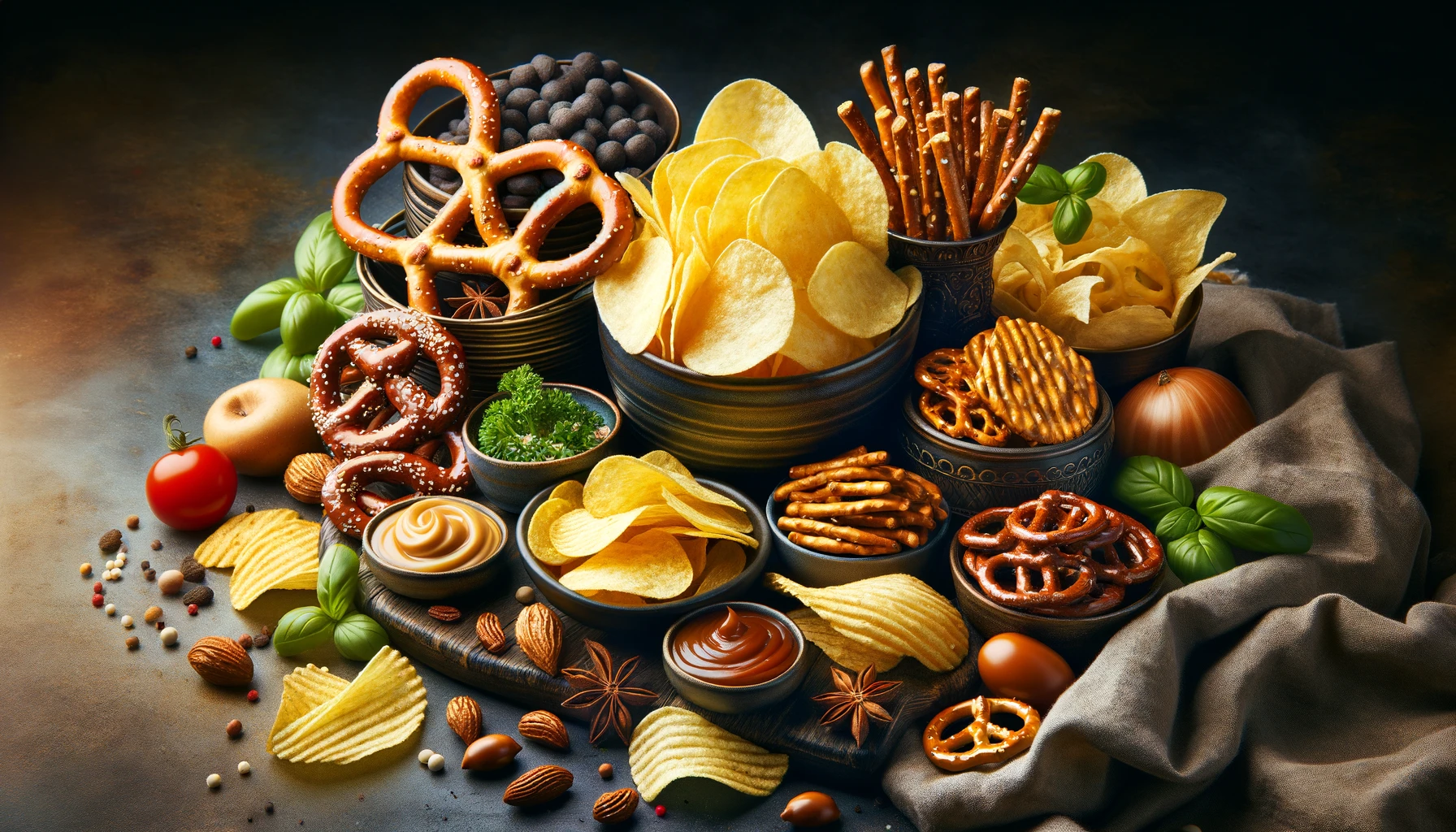Celebrity endorsements might make products appear irresistible, but the reality is much harsher. With over 70% of celebrity food and beverage brands failing, it’s clear that star power alone isn’t enough to guarantee success. From Kylie Jenner’s Glow to Jason Momoa’s Mananalu Water, many celebrity ventures have fizzled despite the fame backing them. Dive into the reasons behind these high-profile flops and discover what it truly takes for a brand to succeed in the competitive market.
The Gourmet Snack Odyssey: Exploring the Evolution, Impact, and Future of a Flavorful Industry
Introduction to the Gourmet Snack Revolution
The snack industry has undergone a significant transformation, driven by a rise in gourmet potato chips and pretzels. This revolution is not just about changing consumer tastes, but a complete redefinition of snack food production and marketing. Brands like Dot’s Pretzels, Dirty Potato Chips, Kettle Chips, Deep River Snacks, and Pop Daddy have been at the forefront of this gourmet evolution, each bringing a unique story of growth, innovation, and success.
The Pioneers of Gourmet Snacking
Dot’s Pretzels
- History: Dot’s Pretzels originated in Dot Henke’s North Dakota kitchen as a family recipe. The brand quickly gained popularity for its distinctive seasoning and taste.
- Growth: The brand expanded organically, initially through local demand, then nationally.
- Acquisition: In 2021, Hershey Co. acquired Dot’s Pretzels for $1.2 billion, a testament to the brand’s value in the gourmet snack market.
Dirty Potato Chips
- History: Starting in Memphis, Tennessee, Dirty Potato Chips introduced a unique ‘dirty’ frying method, leaving the natural potato flavors intact and offering a kettle-cooked crunch.
- Growth: The brand expanded its reach by offering a variety of flavors, maintaining a commitment to all-natural ingredients.
- Acquisition: The brand was later acquired by Utz Quality Foods, though the details of the transaction were not publicly disclosed.
Deep River Snacks
- History: Deep River Snacks began in Connecticut, founded by Jim Goldberg with a vision to provide high-quality, kettle-cooked potato chips made from non-GMO ingredients.
- Growth: Known for its commitment to social causes, the brand rapidly gained a reputation for its ethical approach and quality products.
- Acquisition: In 2017, Arca Continental acquired Deep River Snacks for an undisclosed amount.
Kettle Chips
- History: Kettle Chips started in Oregon in 1978 and became a pioneer in the natural potato chip market in the U.S.
- Growth: The brand was among the first to introduce hand-cooked, all-natural chips.
- Acquisitions: Diamond Foods purchased Kettle Chips in 2010 for $615 million, and later, in 2016, Snyder’s-Lance acquired the brand for $1.91 billion.
Pop Daddy
- History: Pop Daddy began as a small family business focusing on high-quality popcorn and later expanded into pretzels.
- Growth: The brand, founded by Mark Sarafa, is known for its unique flavors and high-quality, non-GMO ingredients.
- Current Status: Pop Daddy continues to grow, maintaining its presence in the gourmet snack market as an independent brand.
Financial and Economic Impacts in the Gourmet Snack Market
The gourmet snack market has witnessed substantial financial growth and potential, evidenced by major acquisitions and investments, reflecting a vibrant and lucrative sector.
Market Dynamics: Size, Growth, and Future Projections
The gourmet snack market, worth several billion dollars, is experiencing steady growth. This sector is expected to continue expanding, driven by trends favoring healthier, artisanal products and innovative flavors. Projections indicate robust future growth, propelled by evolving consumer preferences.
Distribution and Marketing Dynamics
Effective distribution and marketing strategies have been crucial for gourmet snack brands. Strong retail partnerships, innovative merchandising, and robust branding have significantly contributed to the growth and visibility of these products in the market.
Consumer Behavior and Preferences
The modern consumer’s inclination towards snacks that offer both quality and a unique experience has spurred the growth of the gourmet snack segment. The preference for natural ingredients and diverse flavors reflects a broader shift towards health-conscious and ethical food choices.
Innovation in Product Development
Innovation has been pivotal in the gourmet snack industry, with brands continuously experimenting with flavors, textures, and ingredients. This relentless pursuit of excellence has kept these brands at the forefront of the snack industry.
The Crucial Role of Major Snack Distributors
Significant players like Frito-Lay and Utz have shaped the distribution landscape of the snack industry. Frito-Lay’s direct-store-delivery system and Utz’s mix of company-owned and independent routes ensure widespread product availability and freshness. Other major distributors like Snyder’s-Lance and Herr’s have similarly contributed to the efficient distribution of gourmet snacks.
The future of the gourmet snack category is poised to be shaped by evolving consumer preferences and global trends. Here’s an exploration into the potential growth of this dynamic market and the exciting new flavors that might emerge:
Future Growth of the Gourmet Snack Category
The trend toward health-conscious eating is expected to significantly influence the growth of the gourmet snack category. Consumers are increasingly seeking snacks that are not only tasty but also offer nutritional benefits. This includes a demand for snacks that are low in calories, rich in vitamins and minerals, and cater to specific dietary needs such as keto, vegan, or gluten-free. The intersection of health and flavor is likely to be a key driver of innovation in this space.
Global flavors are anticipated to play a major role in the future of gourmet snacks. As culinary boundaries blur, we might see a fusion of tastes from various parts of the world. Ingredients and spices from diverse cuisines like Asian, African, and Latin American could be integrated into traditional snack formats, offering consumers a taste of global cultures.
Sustainability and ethical production are also set to become more important. There is a growing consumer interest in snacks that are produced in an environmentally friendly and socially responsible manner. This encompasses everything from the use of biodegradable packaging to the support of local farming practices and transparent sourcing.
The plant-based movement is another area poised for growth. With a growing number of consumers adopting plant-based diets, there’s a clear opportunity for innovation in this sector. Plant-based ingredients could be used creatively to offer new textures and flavors, meeting the demand for both health-conscious and ethical snacking options.
Functional snacks, offering benefits beyond satiety, are expected to gain popularity. These could include snacks fortified with probiotics, adaptogens, or superfoods, aligning with the trend towards health and wellness.
Emerging Flavors in Gourmet Snacks
The incorporation of ethnic and exotic flavors into snack foods is a trend on the rise. Imagine tasting the spicy and aromatic notes of Ethiopian berbere or the delicate and distinct flavors of Japanese matcha in your favorite snack. This trend reflects a growing consumer curiosity and openness to experiencing new and diverse flavors.
Sweet and spicy combinations are also gaining traction. The contrast of flavors like chili chocolate or sweet and spicy mango offers a unique and tantalizing taste experience. This trend caters to those who enjoy a complex flavor profile that balances different taste sensations.
Herbal and floral infusions are expected to bring a fresh and gourmet touch to traditional snacks. The subtle use of herbs like rosemary and thyme, or floral notes such as hibiscus and elderflower, could add an elegant twist to familiar snacks, elevating them to gourmet status.
The exploration of umami-rich flavors is another exciting possibility. Ingredients known for their umami qualities, like mushrooms, truffles, or aged cheeses, could be used to add depth and a sense of luxury to snack products.
Finally, the concept of nostalgia with a gourmet twist could see classic flavors being reinvented with high-quality, artisanal ingredients. This approach not only appeals to a sense of nostalgia but also caters to a more sophisticated palate.
Conclusion: The Future Landscape of Gourmet Snacking
The gourmet snack market, highlighted by the journeys of pioneering brands, represents a dynamic and evolving sector. This market, characterized by innovative products, strategic business decisions, and evolving consumer preferences, is poised for continued growth and diversification. As the industry progresses, these brands, along with new market entrants, will continue to shape the gourmet snack landscape, offering exciting opportunities and developments for snack enthusiasts globally.







